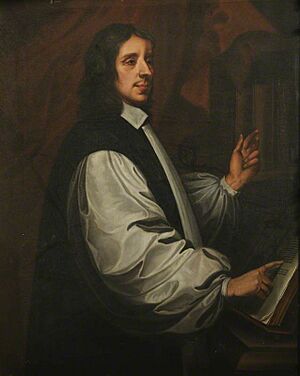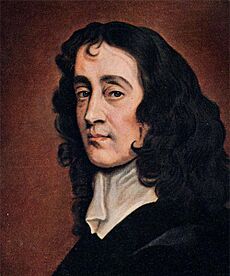John Fell (bishop) facts for kids
John Fell (born June 23, 1625 – died July 10, 1686) was an important English church leader and a very influential person at Oxford University. He was the Dean of Christ Church, a major college at Oxford. Later, he also became the Bishop of Oxford, which is a high-ranking church position.
Contents
Early Life and School Days
John Fell was born in a place called Longworth, which is now in Oxfordshire. His father, Samuel Fell, was also the Dean of Christ Church before him. John went to Lord Williams's School in Thame when he was young.
When he was just 11 years old in 1637, John became a student at Christ Church. He was so good at his studies that he was allowed to get his first degree, a BA, even a bit early. He earned his MA degree in 1643. Later, he became a deacon in 1647 and a priest in 1649, taking his Holy Orders.
Life During the English Civil War
During the English Civil War (a big fight between King Charles I of England and Parliament), John Fell supported the King. He even served as an ensign, which is a junior officer.
In 1648, Parliament took control of Oxford University. Because John supported the King, he lost his student position. For the next few years, he lived in Oxford with his brother-in-law, Thomas Willis. There, he and his friends Richard Allestree and John Dolben secretly kept the traditions of the Church of England alive during a time when it was not allowed.
A Busy Career at Oxford
After the King returned to power in England (this was called the English Restoration), John Fell quickly rose through the ranks. He became a canon of Christ Church and then its Dean in 1660. He also became the King's chaplain and earned his D.D. degree.
From 1666 to 1669, he was the Vice-Chancellor of the University of Oxford. This meant he was a very important leader of the whole university. In 1676, he became the Bishop of Oxford, but he was allowed to keep his job as Dean of Christ Church at the same time. He was even offered the top church job in Ireland, but he said no.
Bringing Order to the University
John Fell was known as a very good leader. He brought back order to Oxford University, which had become a bit messy during the Civil War. He made sure students followed the rules and traditions of the Church of England. He believed strongly in the Church of England and made sure everyone attended chapel and wore the proper academic dress.
He also worked hard to get back church property that had been lost. He helped create a catechism (a book of religious teachings) for children in his area. He was also one of the first church leaders to realize that some people wanted to bring back the Roman Catholic faith to England, and he strongly opposed it.
Fell helped many people convert from the Roman Catholic Church or from other Protestant groups to the Church of England. He also made sure that students attended lectures and that exams were fair. He even encouraged students to put on plays! He stopped a rowdy tradition called "coursing," where students would argue loudly and sometimes fight.
A Strict but Fair Teacher
John Fell was a strict teacher, but he was also very good at educating young men. Many students lived with him. There's a famous story about a student named Tom Brown. Tom was about to be kicked out of Oxford for misbehaving. Fell said he would forgive him if Tom could translate a Latin poem on the spot.
The poem was: Non amo te, Sabidi, nec possum dicere – quare; Hoc tantum possum dicere, non-amo te.
Tom immediately replied with these famous lines:
I do not like thee, Doctor Fell,
The reason why I cannot tell;
But this I know, and know full well,
I do not like thee, Dr Fell.
Fell was amused and let him stay.
However, Fell wasn't always so mild. Another student, Acton Cremer, was punished for trying to get married while still a student. His punishment was to translate a whole book about Lapland! As Vice-Chancellor, Fell would even visit drinking taverns himself to make sure students weren't there.
Building and Improving Oxford
John Fell was very ambitious with his building projects. At Christ Church, he finished a large quadrangle (a courtyard surrounded by buildings) that his father had started. He also rebuilt other parts of the college and, most famously, started building the huge Tom Tower gate in 1681. This tower was finished in 1682, and the famous bell "Great Tom" was moved there. He also helped create the beautiful Broad Walk in 1670.
He spent a lot of his own money on these projects. He also gave money to restore churches and built new ones in other towns. He helped build the Sheldonian Theatre at Oxford, which was meant to be a place for university events instead of using the church. He was in charge of its construction and was a curator (manager) of the building.
The Oxford University Press
The Oxford University Press, a famous publishing house, was set up in the Sheldonian Theatre. This was a project that John Fell cared deeply about. He practically ran it himself. He even brought special printing types and printers from Holland because he believed "the foundation of all success must be laid in doing things well."
Many books were printed under Fell's guidance, including Bibles, classic books, and works by early church leaders. He would often publish one classical book each year and give it to all the students at his college on New Year's Day. He was very protective of the university's printing rights and refused to let others print books if he thought it would compete with his press.
His Writings and Translations
John Fell wrote biographies of his friends, including Henry Hammond and Richard Allestree. He also wrote about the importance of keeping the Church of England strong. Some of his sermons (religious speeches) were printed, though one person, John Evelyn, found them a bit boring.
He was also very skilled in Greek and Latin languages. He helped create new editions of many important ancient texts and religious writings. He even worked on a critical edition of the New Testament.
A Mission to India
Fell also had an idea for a mission to India. The Honourable East India Company supported it. He trained four scholars at Oxford to become missionaries and even got special Arabic printing types. They printed the Gospels and Acts in the Malay language in 1677. However, this mission was not successful and eventually stopped.
His Final Years
John Fell never married. He died in 1686 at the age of 61, described as "worn out" from all his hard work. He was buried in the divinity chapel at Christ Church Cathedral. People remembered him as a great leader, especially for his work at Oxford University. He left money to help poor scholars at his college.
There are two interesting paintings of John Fell at Christ Church. One shows him with his friends Allestree and Dolben. Another is by the famous artist Anthony van Dyck.
See also



